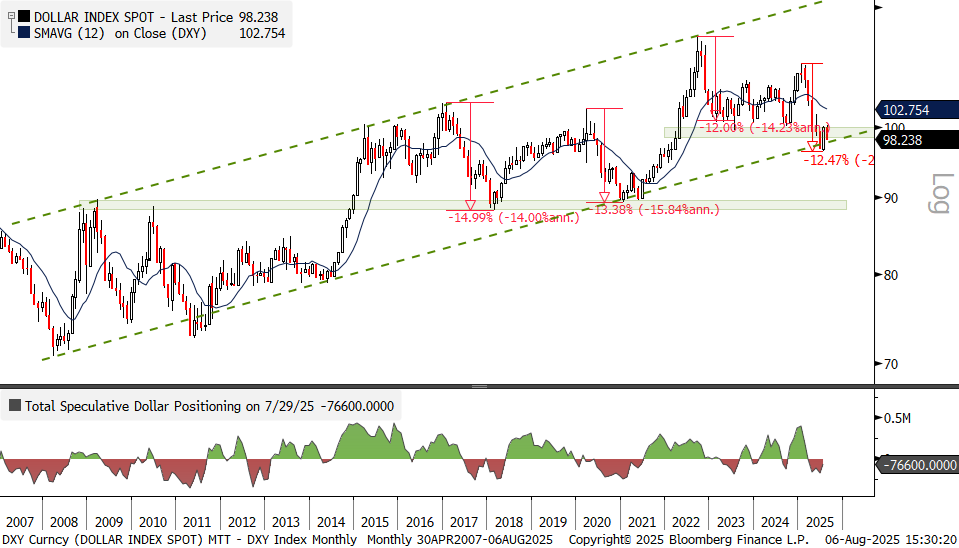The American dollar, symbolised by the DXY, has experienced a noteworthy resurgence over the past month, marking a turning point after its most significant downturn in the first half since its creation in 1973. This resurgence has been propelled by several critical factors including advancements in trade negotiations, a steadfast approach by the Federal Reserve indicating an inclination towards higher interest rates for a prolonged period, economic data surpassing expectations (with the exception of the recent employment figures released last Friday), and a renewed interest in U.S. equities.
The analysis of the dollar’s performance cannot be isolated from its comparison against a basket of world currencies, particularly the Euro, which forms the largest component (58%) of this basket. Here, the dynamics within the Eurozone, encompassing both economic growth and central banking policies, play a significant role in shaping the value trajectory of the U.S. dollar. A closer look at the Eurozone reveals a relatively dovish stance from the European Central Bank (ECB) amid weaker economic growth, contrasting the Federal Reserve’s more hawkish perspective.
Over the last year, the ECB has reduced its target rate from 4% to 2%, including four quarter-point cuts in 2025 alone, with an additional 0.25% cut anticipated by December. This is in stark contrast to the Federal Reserve’s current strategy, maintaining an upper-bound target rate of 4.5% with no rate reductions this year and only a speculative two to three 0.25% cuts by the end of the year. This divergence is further accentuated by the ECB President Christine Lagarde’s cautionary stance on Eurozone’s economic growth being at risk, while Federal Reserve Chair Jerome Powell has maintained a more optimistic outlook on the U.S. economy’s resilience amidst uncertainties.
The recent underwhelming U.S. employment numbers and the vacancy left by outgoing Fed Governor Adriana Kugler’s resignation may hint at a potential shift towards a more dovish Federal Reserve. However, it is unlikely that this would significantly alter the anticipated trajectory of interest rate cuts set for September.
From a broader perspective, the dollar has been part of an overarching uptrend since 2008, managing to stay afloat despite experiencing a 12% fall from its January high, a decline consistent with previous patterns observed since its breakout above the highs of 2009–2010. Notably, the positioning among institutional and hedge fund investors has reached levels that suggest a possible reversal in trend, drawing parallels with past inflection points. A critical challenge for the dollar moving forward will be to maintain its strength above the 50-day moving average near 98.25 and to reclaim its previous range’s lower boundary at 100.75.
Reflecting on the broader context, the dollar’s trajectory has shown remarkable consistency across different periods, notably during the terms of President Trump. Following his election victory in November 2015, the dollar surged approximately 8% before witnessing a considerable 12% decline from its peak. A similar pattern unfolded following the 2024 election, indicating a cyclic nature within its movement. Although the circumstances and macroeconomic backdrop differ, the notion that history may not repeat itself, but often rhymes, seems apt in this case.
In summary, the dollar stands at a pivotal juncture, with indications that its recent uplift could extend further in spite of potential dovish shifts from the Federal Reserve. Compared to Europe, the U.S. economy appears more robust, potentially steering clear of a recession while facing lesser downside risks. The revival of American exceptionalism, primarily driven by the leadership of U.S. technology stocks since the lows of April, has played a crucial role in attracting foreign investment back into the U.S., thereby fostering demand for the dollar. This trend might continue, providing a counterbalance to the adverse effects of a decline in global trade.
Important Disclosures: This document is designed for general informational purposes and does not aim to provide specific financial advice or recommendations for any individual. It is crucial to consult a financial professional before making any investment decisions. Investing carries risks, including the potential loss of principal. No investment strategy or risk management technique can assure a return or eliminate the risk of investment losses.



